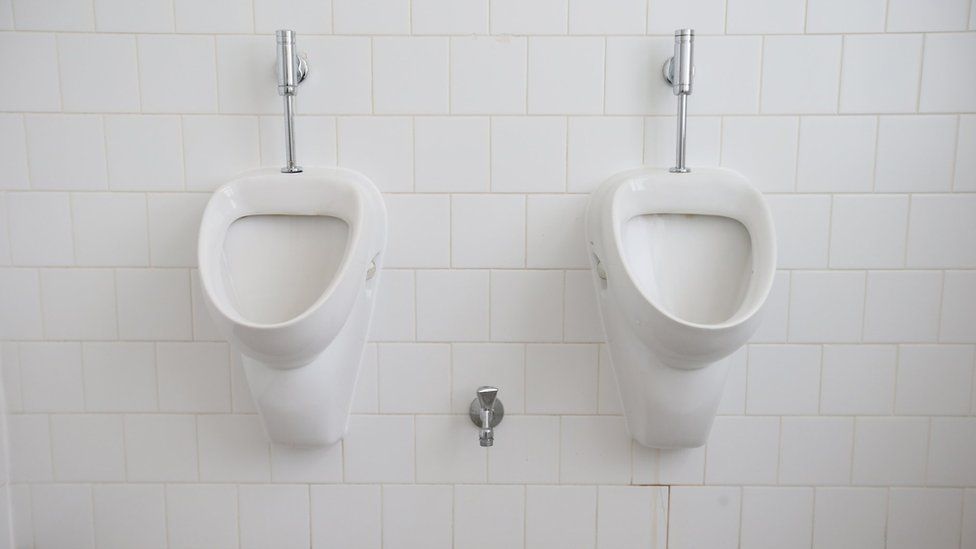Berlin's new toilets: Would you use a women's urinal?
- Published

It's a common problem when you're out and about. Nature calls - but the queue for the ladies is bladder-testingly slow to advance.
Meanwhile your male companion waltzes in and out with what often feels like unfair speed.
Now, the Berlin city authorities plan to address the issue of gender equality in public toilets, as they seek to redevelop the city's conveniences.
All locations that currently have a male-only "pissoir" (public urinal facility) should only exist in combination with unisex toilets, a 99-page city strategy paper called "the toilet concept" concludes.
"In the future urinals which can be used by all genders should be offered," the paper says.
The provision of urinals for women "could be a subject for the continuation of the [toilet] concept and an opportunity for Berlin to show that it is innovative," it adds.
The authors write that pissoirs serve a useful purpose, as they are an effective measure against the problem of "Wildpinkeln" (outdoor peeing, generally by men).
It is not yet clear whether standing up to urinate will be acceptable to most Berlin women, or whether they will demand screens and/or separate cubicles.
More toilet issues:
Other attributes the future "Berliner toilet" needs to have include good visibility at the entrance, well-lit exterior, emergency alarm, as well as discrimination-free pictograms.
But what do Berlin's women think about future toilet provision in their city? And has anyone actually tried a female urinal?
The toilet concept has been put together by Berlin's state government, which is currently controlled by left-wing coalition.
The administration's paper shows photos of people discussing the plans at focus groups earlier this year.
This conservative CDU-linked Berlin woman is sceptical. "Why does [the state government] want me to pee standing up?" she asks.
Allow Twitter content?
This article contains content provided by Twitter. We ask for your permission before anything is loaded, as they may be using cookies and other technologies. You may want to read Twitter’s cookie policy, external and privacy policy, external before accepting. To view this content choose ‘accept and continue’.
"There are more important topics for us women!" she writes, "safety on public transport for example".
This Swiss-based woman tried out a woman's urinal in a theatre in Winterthur. "That is something," she said:
Allow Twitter content?
This article contains content provided by Twitter. We ask for your permission before anything is loaded, as they may be using cookies and other technologies. You may want to read Twitter’s cookie policy, external and privacy policy, external before accepting. To view this content choose ‘accept and continue’.
Though her use of the hashtag #fail suggests she struggled.
A German specialist in toilet design, Prof Mete Demiriz, told the website jetzt.de that unisex urinals could save water, because a survey suggested that women often flush a public toilet three times during one visit.
His team's design for a women's urinal, a prototype of which is installed at his university in Gelsenkirchen, includes a cubicle with a door. The system is like a men's urinal, only lower, Prof Demiriz told the website. The user has her back to the wall, and hunkers down as if skiing, he said.
There are other women's urinals in existence, including a design called "Girly" by Italian firm Sintesibagno.
It is not clear whether Berlin plans to put forward one design of urinal that could be used by both men and women.
Some festivals - and the Shanxi Normal University in Xian, in China - have provided standard urinals for women plus a disposable cardboard device to help them to use them.
And providing gender-neutral toilets - helpful for some transgender people - can backfire, as London's Barbican Centre found out to its cost earlier this year.
People complained that the queues for women at the arts centre just got longer, after the signs on one set of toilets were changed to "gender-neutral toilet with urinals and cubicles" and "gender-neutral toilet cubicles only".
- Published6 November 2013
- Published20 March 2014
- Published9 August 2017